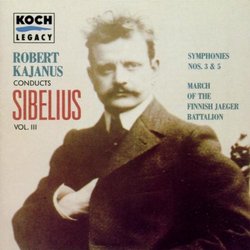| All Artists: Sibelius, Kajanus, Lso Title: Symphnies 3 & 5 Members Wishing: 0 Total Copies: 0 Label: Koch Entertainment D Release Date: 1/25/1995 Genres: Special Interest, Classical Styles: Marches, Opera & Classical Vocal, Historical Periods, Modern, 20th, & 21st Century, Symphonies Number of Discs: 1 SwapaCD Credits: 1 UPC: 099923713326 |
Search - Sibelius, Kajanus, Lso :: Symphnies 3 & 5
 | Sibelius, Kajanus, Lso Symphnies 3 & 5 Genres: Special Interest, Classical
|
Larger Image |
CD Details |
CD ReviewsWHAT'S IN A NAME? DAVID BRYSON | Glossop Derbyshire England | 01/30/2004 (4 out of 5 stars) "This is Kajanus, not Karajan. I say this not to labour the obvious but to try to give record-collectors a reasonable idea of what to expect and what not to expect. Kajanus was a professor of music, not a professional conductor. Chording is often more than a little ragged in a way his near-namesake would never have stood for. However when it comes to their respective versions of the wonderful fifth symphony there is no doubt in my mind which I would sooner own if it came down to one. As it happens, I own both, and I know which is the one I listen to. As well as his legendary professionalism and technical proficiency, Karajan has the advantage of modern recording, although Kajanus is not badly at all recorded for the 1930's. When it comes to insight and vision, Karajan simply drops out of mine as far as this work is concerned. For me neither he nor anyone else comes within a mile of Kajanus.The fifth gave Sibelius more trouble than anything else he composed. At its first performance it was in four distinct movements. Sibelius was dissatisfied and withdrew the work, reissuing it with the familiar bridge section between the opening Molto Moderato and the waltz-like 3/4 section. This, it appears, was the bit that had given him most of the heartache, and for me it is one of the most wonderful sequences he ever conceived. I never knew how wonderful it was until I heard it from Kajanus, like low clouds scudding across a rainy sky. Kajanus was a friend (most of the time) of the composer, but that alone could not have given him the insight and unique grasp that he shows here so spectacularly. Together with the way he does the concluding sequence of Tapiola, this piece of interpretation puts Kajanus in a league entirely of his own as an interpreter of Sibelius, come Beecham come whoever.This is only a particular high spot. The whole piece is wonderfully realised, and so is his version of #3. This seems to me a piece in which the truly mature and individual Sibelius style is, so to speak, struggling out of its cocoon. The last movement already anticipates the great last movement of #5, particularly in respect of the theme that Tovey so memorably likened to Thor swinging his hammer. Perhaps the middle movement is the best, and all my life I have been particularly fond of the Collins version with its very mouvemente tempo. Kajanus is slower, the characteristic ambiguity of rhythm as between twice three and thrice two is very strongly pointed up, and once again the peculiar sense of near-prophetic insight is with me strongly as I listen to his account.If I can't give the disc 5 stars that is because of the recorded quality and nothing whatsoever to do with ragged chording or anything of the sort. I am a music-lover not a perfectionist. Whatever there is to admire in Karajan in the fifth (a great deal), or in Collins in the third (a great deal more), there is nobody quite like Kajanus."
|

 Track Listings (7) - Disc #1
Track Listings (7) - Disc #1